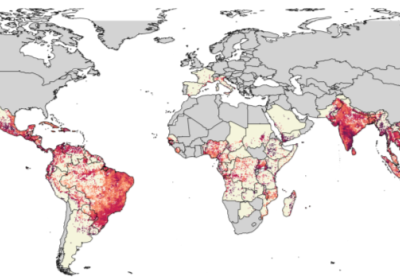
Maps developed using a sophisticated machine learning model reveal that more regions are at risk of chikungunya than previously anticipated, with India potentially facing the most significant long-term impact. This revelation comes from the most comprehensive mapping of chikungunya’s global risk to date, conducted by researchers from the London School of Hygiene & Tropical Medicine (LSHTM), Nagasaki University, and the International Vaccine Institute in Seoul.
The study aims to enable countries to better prepare by mapping all possible regions where chikungunya infections could occur and estimating the age groups and areas most at risk of long-term effects. This information is crucial for targeting possible vaccine programs effectively.
According to the infectious disease model based on existing evidence of chikungunya transmission, approximately 14.4 million people globally could be at risk of infections each year, with 5.1 million at risk in India alone. The analysis suggests that chikungunya cases could spread to regions not currently recording infections, potentially increasing the number of people at risk to 34.9 million globally, with 12.1 million in India.
Global Impact and Long-term Concerns
India, Brazil, and Indonesia rank as the top three countries most likely to experience substantial long-term impacts from chikungunya. India and Brazil alone account for 48% of the global impact on healthcare systems and individuals. The analysis highlights chronic health impacts as the primary concern, with evidence suggesting that around 50% of those infected experience long-term disability.
Chikungunya outbreaks have become a growing public health concern, reported in over 114 countries since its re-emergence in 2004. The virus, spread by Aedes aegypti and Aedes albopictus mosquitoes, causes severe joint pain and high fever in those infected. While most patients recover from the initial phase, over 50% suffer from long-term joint pain and disability, and cases can occasionally be fatal. Currently, there are no specific treatments for chikungunya, but two preventative vaccines have been approved in some countries.
Innovative Mapping and Predictions
This study is the first of its kind to predict the burden of chikungunya using machine learning to combine existing infection data with other influential factors. These factors include the presence of Aedes mosquitoes, suitable temperatures for virus transmission, annual precipitation, environmental suitability for virus spread, and national GDP levels.
Previous studies have estimated the chikungunya burden primarily through surveillance and outbreak reports, which often underestimate the true number of cases. The model predicts how many people at risk may become infected each year, based on the force of infection. A higher force of infection generally indicates a quicker spread, making explosive outbreaks more likely.
On average, between 1.2-1.3% of people at risk of chikungunya could expect to be infected per year, which is lower than the risk of dengue (6%). However, certain countries, like Gabon, could see infections in up to 11% of people at risk.
Expert Insights and Future Strategies
Hyolim Kang, who led the study as part of her PhD at LSHTM, emphasized the unexpected risk beyond subtropical or tropical regions. “Prevention of the spread of this disease is important for everyone,” she stated, highlighting the lack of specific antiviral therapies for chikungunya.
Sushant Sahastrabuddhe, a co-author of the study, stressed the importance of real-time modeling to assist public health professionals in managing current cases and preparing for future outbreaks. Kaja Abbas, a senior author, noted that the model-based estimates could inform immunization strategies using the two licensed vaccines, Ixchiq® and Vimkunya®, in Brazil and globally.
The researchers acknowledge that their maps represent a long-term annual average and do not account for unexpected changes such as extreme weather events or climate change impacts. They hope their findings will inform global prevention strategies, including efforts by the WHO SAGE Working Group on Chikungunya Vaccines.
The study, titled “Global, regional and national burden of chikungunya: force of infection mapping and spatial modelling study,” is published in BMJ Global Health.







